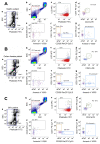Circulating Extracellular Vesicles Are Increased in Newly Diagnosed Celiac Disease Patients
- PMID: 36615729
- PMCID: PMC9824360
- DOI: 10.3390/nu15010071
Circulating Extracellular Vesicles Are Increased in Newly Diagnosed Celiac Disease Patients
Abstract
Extracellular vesicles (EVs) are a class of circulating entities that are involved in intercellular crosstalk mechanisms, participating in homeostasis maintenance, and diseases. Celiac disease is a gluten-triggered immune-mediated disorder, characterized by the inflammatory insult of the enteric mucosa following local lymphocytic infiltration, resulting in villous atrophy. The goal of this research was the assessment and characterization of circulating EVs in celiac disease patients, as well as in patients already on an adequate gluten-free regimen (GFD). For this purpose, a novel and validated technique based on polychromatic flow cytometry that allowed the identification and enumeration of different EV sub-phenotypes was applied. The analysis evidenced that the total, annexin V+, leukocyte (CD45+), and platelet (CD41a+) EV counts were significantly higher in both newly diagnosed celiac disease patients and patients under GFD compared with the healthy controls. Endothelial-derived (CD31+) and epithelial-derived (EpCAM+) EV counts were significantly lower in subjects under gluten exclusion than in celiac disease patients, although EpCAM+ EVs maintained higher counts than healthy subjects. The numbers of EpCAM+ EVs were a statistically significant predictor of intraepithelial leukocytes (IEL). These data demonstrate that EVs could represent novel and potentially powerful disease-specific biomarkers in the context of celiac disease.
Keywords: celiac disease; extracellular vesicles; flow cytometry; gluten-free diet regimen (GFD).
Conflict of interest statement
The authors declare no conflict of interest.
Figures





References
MeSH terms
Substances
Grants and funding
LinkOut - more resources
Full Text Sources
Medical
Research Materials
Miscellaneous

